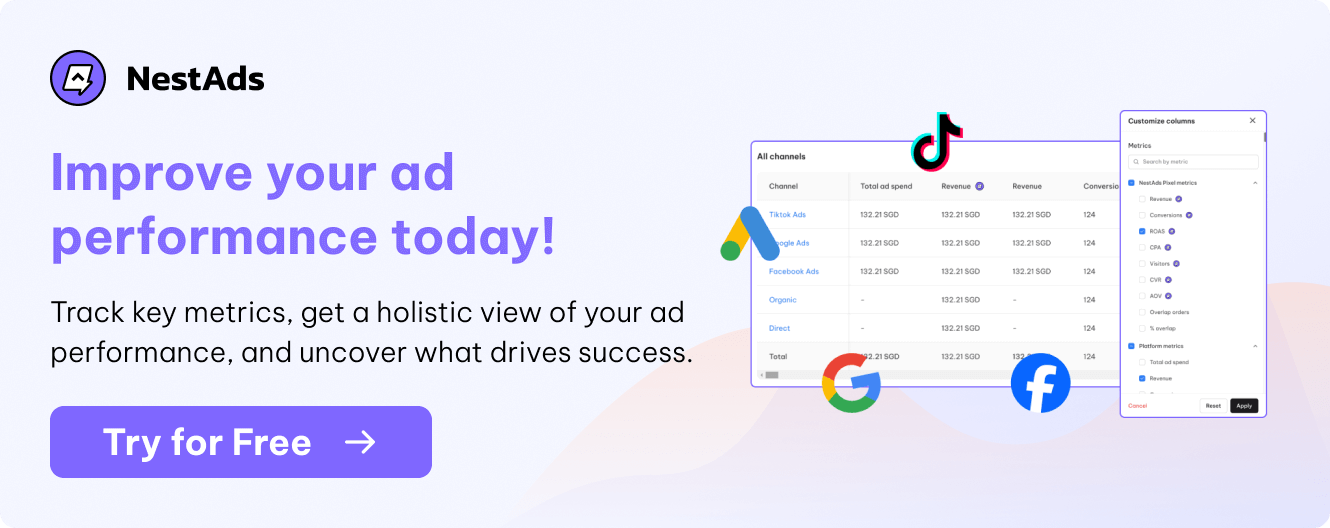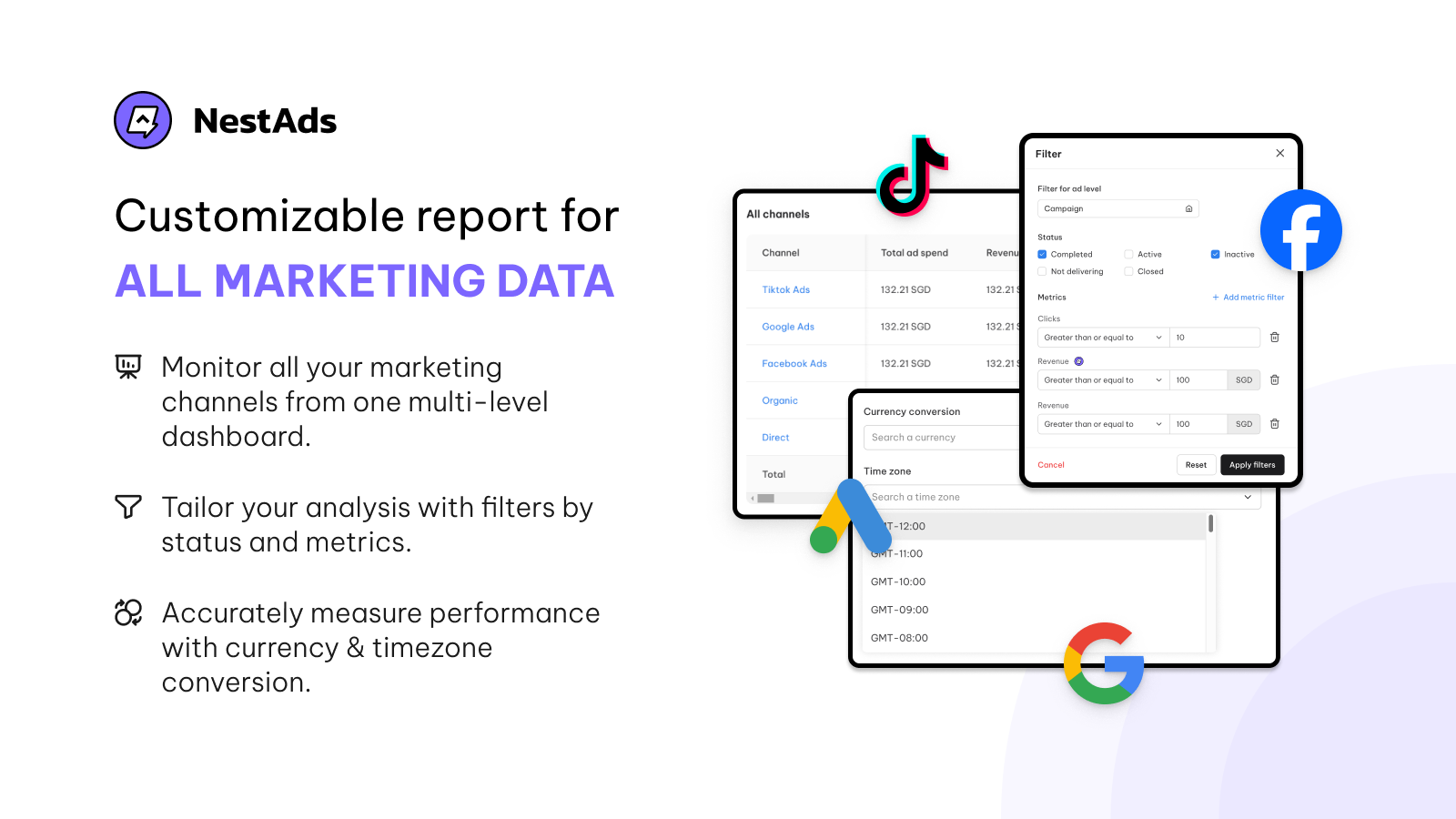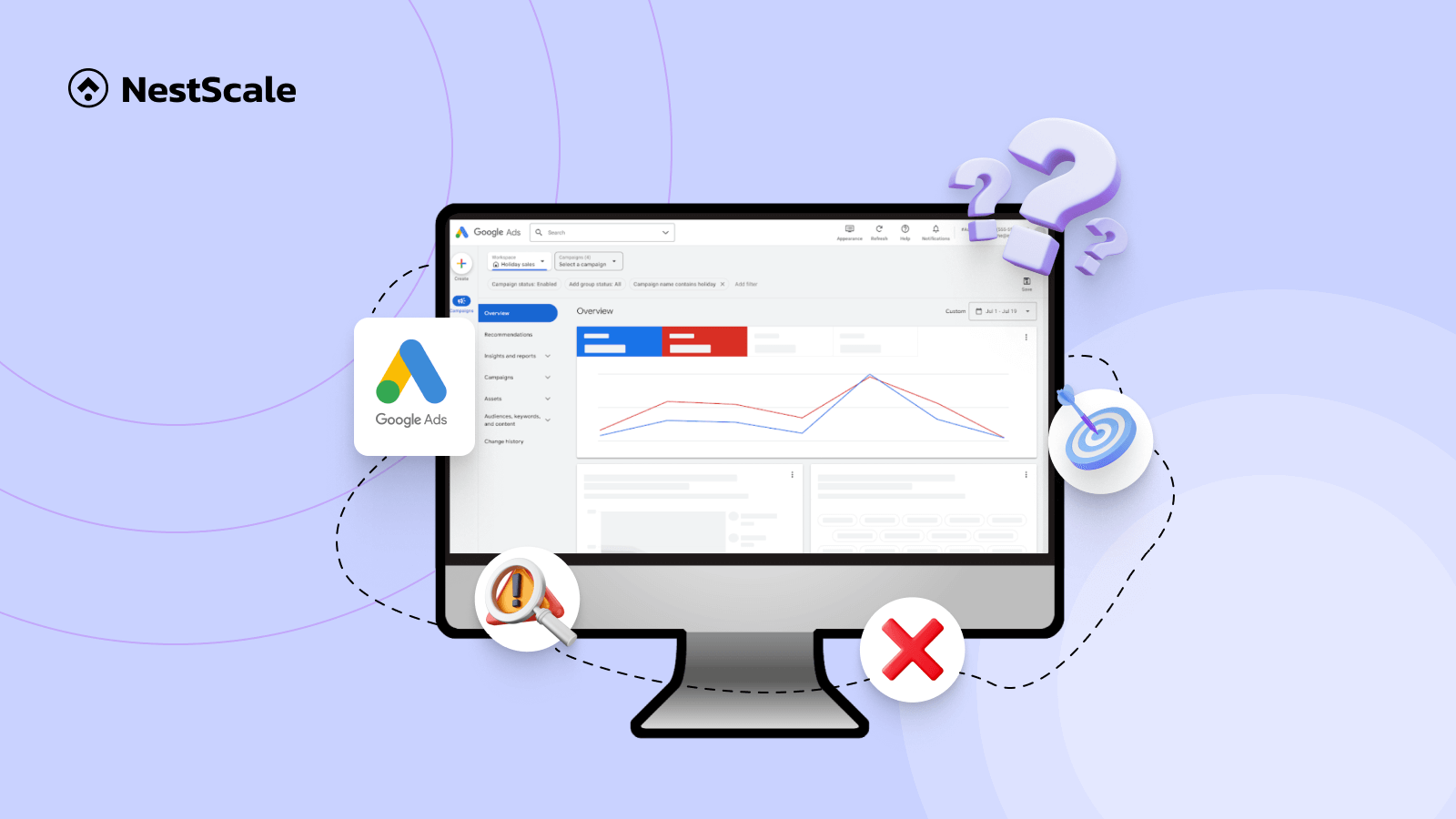Google Ads often face disapproval due to an automated review process lacking human judgment, leading to mistaken categorizations. In the next section, we’ll guide you on handling these disapprovals and preventing them.
Disapproval doesn’t mean a permanent ban; most issues are easily resolved, typically stemming from common errors. In this article, we’ll break down the 14 most frequent reasons why ads get rejected and walk you through how to get them back on track!
14 reasons why your Google Ads disapproved & solutions to fix
When your Google Ads face disapproval, the issues may be related to four main areas: spelling, ad quality, Google Ads policy, or your destination. Let’s explore the 14 common reasons why your Google Ads may get approved.
Spelling and grammar issues
Google’s search ads serve as the epitome of professionalism, upholding stringent standards for user experience. This encompasses strict spelling and grammar rules imposed on advertisers. Instant rejection awaits any ad containing typos or misspellings.
Consequently, it’s essential to be mindful of certain spelling and grammar issues to prevent your ads from being disapproved for these reasons:
Capitalization
Don’t let caps lock sabotage your ads! Google’s policy prohibits excessive capitalization, and exceeding it can lead to disapproval and rejection. Think of it as shouting, which might be appropriate in casual settings, but not in professional advertising. Stick to the proper case and avoid unnecessary capital for a polished and policy-compliant message.
You might catch these familiar capitalize issues:
- Not capitalizing the first letter of proper nouns (e.g.: “the nearest park in melbourne, australia”)
- Capitalizing non-proper nouns (e.g.: “The Nearest park in Melbourne, Australia”)
- “Random” capitalization (e.g.: “tHe neaReST ParK iN MelbourNe, AustraliA”)
How to fix:
The solution is really easy: Capslock when needed. Remember, uppercase letters stand out, so reserve them for sentence beginnings and important names like brands and products. For everything else, lowercase keeps things smooth and easy to read.
Punctuation and symbols
Google Ads prioritizes clarity and professionalism, so it demands grammatically sound ad copy free from excessive punctuation or symbols. Here are some examples:
- The exclamation mark in the ad headline
- More than one exclamation point in the description copy
- Excessive commas, dashes, or any other symbol
- Non-standard symbols or characters, such as asterisks; bullet points, and ellipses
- Non-standard use of superscripts
- Symbols, numbers, and letters that don’t adhere to their true meaning or purpose (e.g.: “@ park” to mean “at park”)
- Gimmicks like misspellings, symbol patterns, or excessive punctuation. (e.g.: f1owers, fl@wers, Flowers!!!, f*l*o*w*e*r*s, F.L.O.W.E.R.S)
- Invalid or unsupported characters, such as emojis

How to fix:
Keep the punctuation and symbol party to a minimum. But if your brand or product rocks funky symbols, Google might still get the green light as long as they stay consistent across your ad and your landing page. Common symbol applications, like using asterisks for star ratings, are generally accepted.
Using non-standard spacing
Google values accuracy and professionalism in ad copy, including proper spacing. Missing (e.g. “thenearestpark”) or excessive spaces (e.g. “the . nearest . park”), as well as gimmicky spacing patterns (e.g. “The N e a r e s t park”), can trigger disapproval for “improper grammar.” To avoid this, ensure consistent and standard spacing throughout your ad text. Bullet points and numbered lists fall outside Google Ads guidelines, as ad copy should be read as a single, concise message.
How to fix:
Some trademarks, brand names, or product names might embrace non-standard spacing. If your ad features one such term and triggers spacing disapproval, consider requesting a review.
Provide evidence showcasing the consistent use of this non-standard spacing throughout your website or app, demonstrating it’s not an isolated case in your ad copy. This can help resolve the potential disapproval.
Repetition
Google values unique and informative ad copy. To maximize your character limit, they’ll reject ads that contain repetitive content, including names, words, phrases, and even excessive punctuation (e.g., “Want more customers????”).
How to fix:
The solution is avoid to using the same wording in your ad title, description, and extensions.
Destination not working
Google may disapprove your ads if issues related to your destination not working, make it difficult for the audience to navigate to your store’s landing page. To ensure a seamless experience for your audience, here are some problems you need to avoid:
Destination mismatch
Destination mismatch occurs when though the ads are grouped, their click destinations (URLs) are not the same.
You might see these common destination mismatch cases:
- Discrepancies between display and landing page URLs: Ads promising a visit to “www.example.com” but whisking users away to “www.example2.com” won’t fly with Google. Show users exactly where they’re going and avoid landing page surprises.
- Keyword-stuffed URLs in display domains: Tempting as it may be, using keywords like “[keyword]” in your display URL (“www.[keyword].com”) is a no-go. Keep it clean and clear to avoid raising red flags.
- Unclear subdomain structure: Help users navigate your site with confidence. Use subdomains to distinguish your ad’s specific landing page (“mycompany.example.com”) from the broader website (“example.com”).
- Unexpected domain redirects: Ensure redirects from your final URL (e.g., http://example.com) stay within the same domain, avoiding sudden jumps to http://example2.com.
- Tracking templates leading astray: If your tracking template sends users to a different page than the intended final URL (e.g., product category vs. specific product), you’re setting yourself up for disapproval. Keep the journey consistent and avoid confusing detours.
How to fix:
Resolving destination mismatch disapprovals is straightforward. Determine the desired final URL for all ads in the ad group and update accordingly. Remember, even paused ads should point to the same path.
If you need diverse landing pages, group the ads accordingly. Campaigns cannot have final URLs leading to different domains, but they can contain ads with different URLs within them. Similarly, accounts can have ads pointing to multiple domains, but individual campaigns cannot.
Destination not working
Imagine clicking on an ad, only to land on a broken page or one that’s completely different from what you expected. That’s what Google Ads means by “Destination not working.” Your ad’s URL either leads to the wrong place or the page itself isn’t functioning properly.

How to fix:
“Destination not working” is a frequent disapproval with diverse causes. Resolving it might involve technical adjustments like modifying your site code or adding a “robots.txt” extension for crawler access. Conversely, a simple typo in your ad’s final URL could be the culprit, requiring a quick fix.
Google Ads policy violations
The most common issues that can result in your ads not being approved by Google are primarily related to violations of Google Ads policies. Typically, Google will promptly notify you if your ads are not approved due to such problems. Now, let’s explore some of the most common situations you might find yourself in:
Malicious software
A “Malicious software” disapproval on your Google Ads indicates Google’s detection of potential security risks or harmful software linked to the URL in your ad. This protective measure shields users from encountering malicious websites or programs.
How to fix:
Diagnosing this particular disapproval can be trickier, often involving website code or linked content. To expedite resolution, consider seeking clarification from Google regarding the specific location of the issue within your site.
We strongly recommend a thorough code audit by your webmaster to identify any potential anomalies. This proactive approach can streamline the troubleshooting process and expedite resolution.
Unsuitable content
Ads deemed inappropriate by Google due to their content or topic will be disapproved. Here are some examples of prohibited content include:
- Counterfeit goods: Imitation products attempting to mislead consumers.
- Enabling dishonesty: Products/services facilitating user deception or unauthorized access.
- Inappropriate content: Content causing harm, offense, or shock, involving sensitive events or animal cruelty.
How to fix:
While the previously mentioned content falls under complete restriction, Google permits the following on a limited basis: adult content, alcohol, gambling, healthcare, political messaging, and financial services.
However, these categories may not be universally restricted, and specific geographic variations exist. Advertisers must comply with additional requirements outlined in the Google Ads Policy Center for these categories to ensure ad eligibility.
If sensitive content is necessary, you can opt for a “limited approval” with stricter targeting options by first disputing the incorrect disapproval through the steps outlined below.
Dishonest behavior
Google Ads that contain deceptive elements like false claims, misleading language, or inaccurate representations of the promoted product or service are susceptible to disapproval.
How to fix:
This disapproval is a serious matter. A single violation can lead to account suspension within seven days. Avoid promoting spyware, hacking services, illegal documentation, exam answers, drug test passing supplies, or sensitive information like banking numbers. If you receive this disapproval, immediately revamp your ad and landing page or seek assistance from Google support.
Industry-specific disapprovals
Google Ads may be disapproved if the content of the ad is related to certain industries that Google restricts or prohibits. This could be due to various reasons such as legal restrictions, sensitive content, or Google’s policy on maintaining a safe and positive user experience.
How to fix:
Be mindful of your industry and any potentially sensitive topics within it, as Google may raise concerns. If your ad carries potential risks, start cautiously with a neutral search ad and gradually refine your approach.
Targeted advertising can be tricky in certain industries like healthcare, alcohol sales, senior care, housing, and financial services. This is because personalized targeting may be restricted or unavailable, limiting audience exclusion and remarketing options.
Alternate CTA
Google Ads operates on a cost-per-click (CPC) model, which means Google earns money when users click on ads. Therefore, Google prioritizes the click as the main call-to-action (CTA) and may disapprove ads that include alternate CTAs that could discourage a click. For example, ad copy cannot include:
- A phone number
- An email or website address
How to fix:
Instead of cluttering your ad copy with contact information, utilize dedicated ad extensions to showcase your business phone number, email address, and relevant website links. For maximizing phone inquiries, consider call-only ads or call extensions, while site link extensions effectively guide users to specific regions of your website.
Copyrighted content
Copyrighted content in Google Ads comprises any material that is protected by copyright law and is used in your ad campaign without proper authorization. This can include text, images, logos, videos, or music.
How to fix:
The most important thing is to remove it from your ad campaign immediately. And there are many online resources where you can find royalty-free images, music, and other content. So, you can use them without obtaining permission.

Poor ad quality
Finally, Google Ads is stringent when it comes to the quality of your ads. The platform incorporates metrics like Google Ads Optimization Score and Quality Score, allowing you to fine-tune and optimize your ads for the best quality. Therefore, to secure approval from Google for your ads, it is essential to ensure and enhance the quality of your ads.
Now, let’s delve into some common issues related to the quality of your ads, explaining why they might not be approved and providing solutions on how to address them:
Misrepresentation
Google wants its ads to be the real deal, not clickbait or scams. That’s why they need ads to be clear, honest, and helpful. They frown upon stuff that hides info, promises things you can’t get, or lies about what you’re getting.
Some things to avoid:
- Lack of information
- Unavailable offers
- Misleading content
- Unclear relevance
- Hide your brand or company information
How to fix:
The Google Ads disapproval for misrepresentation can stem from a variety of factors. To address this, a thorough review and reevaluation of your content is essential. If you are confident in your adherence to the policy guidelines, it is advisable to double-check for any potential discrepancies or outdated information that may have contributed to the violation. Correcting any such discrepancies can pave the way for resolving the disapproval.
Low-quality image
Low-resolution, excessively small, or text-heavy images can trigger Google Ads disapprovals due to their impact on user experience and ad effectiveness.
How to fix:
Simply replace it with another option. Maintaining diverse creative assets, including images, is good practice for handling such situations and allowing for rapid resubmission.
For those truly attached to a specific image, ensure it complies with Google’s image quality guidelines. Addressing any potential issues like low resolution or excessive text can pave the way for a successful display ad run.
We’ve condensed key issues and solutions to help you swiftly address and gain approval from Google Ads. Check them out in just 10 seconds to efficiently resolve the situation!
Tips to avoid being disapproved by Google
Ad disapprovals can be disruptive, and proactive prevention is the most effective strategy. While complete avoidance may only sometimes be feasible, these tips offer valuable guidance for staying ahead of every disapproval.
Landing page checkups as a habit
A key takeaway is that many common ad disapprovals stem from issues outside your Google Ads account, specifically within your website’s content or final URL. Therefore, meticulous monitoring of your website is equally crucial as reviewing your ad content.
Monitor your Google Ads Quality Score
Google Ads offers a valuable metric known as the Google Ads Quality Score, allowing you to monitor the quality of your ads. By diligently tracking this metric, you gain insights into enhancing how your ads are presented to the audience.
Additionally, it provides clues on improving your landing page to further enhance the overall quality of your ads. Therefore, it’s crucial not to overlook the use of this metric in your advertising strategy.
Understand and stay updated with Google Ads policy
It’s important to understand Google Ads policies by familiarizing yourself with guidelines on prohibited products, deceptive claims, offensive content, and technical requirements. Additionally, stay updated on policy changes, as Google may revise its policies periodically, so be sure that you’re always compliant.
Google Ad Manager policy change log may be helpful for you. It announces updates to its policies and restrictions for Ad Manager through this document.
Track your ad performance regularly
You should set a schedule to track your ads on a regular basis. This is a very important step that many people may neglect. You can spot problems such as low CTR, high bounce rates, or poor landing page experiences before they lead to disapprovals.
We promise you don’t want your ads to stop driving conversions, so anytime you notice poor results in key metrics. You need to make timely adjustments, such as refining your targeting, adjusting your ad copy, or improving your landing page to avoid any worsening situation.
Also, have a robust tracking tool to be your assistant. If you’re Shopify merchants, we have compiled some of the most powerful Shopify Analytics tools for you in this blog.
You can also consider NestAds. It can simplify your tracking process when you just need to install the app and all data reports across channels are ready for you.

FAQs
Why are my Google Ads continually disapproved?
When your Google Ads are continually disapproved, try these steps:
1. Run the Google Transparency Report to verify whether Google has flagged your website for security issues such as malware, phishing, or other harmful content.
2. Contact experts to check if your site has malware or hacking. You should also include software (plugins) on the website that continuously checks for problems, like malware or vulnerabilities.
Under the circumstance that all these checks show your site is safe, Google Ads is still flagging your site. You should appeal to Google, then provide the Google Transparency Report or any evidence showing your site is clean and wait for their response.
How do I appeal a disapproved Google Ad?
1. In the “Status” column of the ad you’d like to dispute, hover over the ad status and select Appeal.
2. Next, under “Reason for appealing” choose either Dispute decision or Made changes to comply with policy.
3. Then, under “Appeal the following” specify which ads you wish to appeal.
Finally, click Submit to complete the process.
For more details, you can read Google’s guide to fix ads with policy violations.
And, until the appeal is resolved, your ad will remain disapproved and you can’t run it.
How long will Google process my appeal?
You can expect Google to resolve your response within a few weeks. However, in some cases, it may take longer.
The time it takes for Google Ads to resolve an appeal can vary greatly. It depends on several factors, including:
- Complexity of the issue: More complex cases may require more time for review.
- Amount of evidence provided: The more evidence you can provide to support your appeal, the faster Google may be able to make a decision.
- Workload of the review team: The volume of appeals being processed can also affect the turnaround time.
What to do when my Google Ads account is suspended?
In the worst case, you’re no longer dealing with disapproved ads, now your Google Ads account has been suspended entirely. You should check out our YouTube video on how to reactivate your suspended account right away.
Just take a few minutes, it walks you through practical steps to resolve account suspensions and get your ads back online:

























































